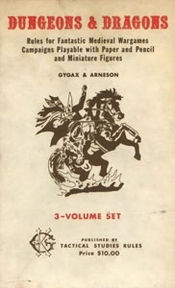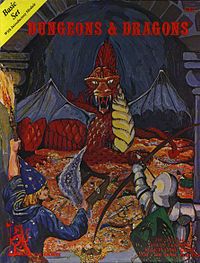I guess I’ve always been a board-gamer. I played various “kid” style board games when I was truly a kid, then in the early 1960s (when I was 10 years old) a friend of mine bought the board game “D-Day” from the Avalon Hill company. Wow. What a difference from other games. Most games (even the early cheesy Milton Bradley “war” games) had one side move one piece, then the other side moved a piece, etc, but with the D-Day game one side moved as many of their pieces as they wanted, then did all of their attacks, then the other side took a similar turn.
My friends and I then bought just about every Avalon Hill game there was. We wore out a couple copies of Blitzkrieg by playing it so much. Starting around 1970 or ’71, we went to local board game conventions (gamecons) and played all sorts of games. Then in the mid-1970s, I became aware (at the gamecons) that some folks were playing a new kind of game, a role-playing game named Dungeons & Dragons.
While at one of the local gamecons, I bought the original D&D rules booklets (1974 printing). There were three small booklets in the original set: Men & Magic; Monsters & Treasure; and The Underworld & Wilderness Adventures; plus a set of Reference Sheets. I also later bought the add-on booklets Greyhawk and Blackmoor (May & November 1978 printings, respectively). The booklets said “Rules for Fantastic Medieval Wargames Campaigns Playable with Paper and Pencil and Miniature Figures.” There were two problems, though, as none of my game-playing friends wanted to play D&D, not to mention the rules were sort of weird to try to figure out on your own.
I did get an introduction to playing D&D at the local gamecons, but I didn’t spend much time at all playing D&D at the cons as I was more into various board games at the time. So basically I just set aside the rule books for a few years.
Then, in August 1979, a teenager named James Dallas Egbert III mysteriously disappeared from the campus of Michigan State University in East Lansing, Michigan. Some folks who are old enough will remember the story, but if you don’t know about it, click the link above for more information. It seems that young Mr. Egbert (who was enrolled at MSU at age 16) would sometimes play Dungeons & Dragons, and the game’s name suddenly entered popular culture as various news organizations were trying to make a link to Egbert’s disappearance while “live playing” D&D in steam tunnels beneath the MSU campus. While Mr. Egbert’s life turned out to be a tragedy in that he commited suicide in August 1980, it did put D&D into the public eye.
Suddenly, in late 1979, all of my friends who had not formerly been interested in playing D&D started asking me about the game. “You have that game, right? How about showing us how the game plays?” I told them that nobody gets to watch others play the game, but they must play the game themselves if they wanted to find out anything about it. By that time I also owned the D&D “Basic Set” of rules that were a lot easier to decipher than the original rules booklets. It also came with module B1: In Search of the Unknown.
I also had just purchased the first Advanced Dungeons & Dragons books, the Monster Manual, the Players Handbook, and the Dungeon Masters Guide (which had just come out), but as I hadn’t yet had time to read through all of those AD&D books, I decided to run a dungeon for my friends using the Basic Set rules (with the “blue” rulebook).
Unfortunately, the date is lost to history, but sometime in late 1979 (I would guess it was September, shortly after James Egbert had disappeared) I got together on a Friday evening after work with several friends, and we played D&D. Naturally, I was the Dungeon Master (DM) as I was the only one who knew anything about the game. We spent a little time generating their first characters, then down they went into the dungeon!
On that first Friday evening of playing D&D, we got started around 8 pm and finished around midnight. I figured that would be the end of things, as now my friends had finally experienced D&D, and I had blooded myself as a first-time DM. But instead, at midnight, the players were raving and excited! “When can we play again!?” they all clamored. I answered, “How about next weekend?” They all shouted, “Can’t we play any sooner? Like tomorrow?” The following day was a Saturday, so I said, “OK, we can get together again in the evening.” But they wanted to play sooner, like 10 am! We finally bargained on a starting time of noon on Saturday.
So we got together again at noon on Saturday, and played until midnight. By now, it seems the initial adventurers were totally hooked on the game. At midnight on Saturday, once again they all pleaded to play again the following day, on Sunday. So we played again on Sunday, from around noon to 6 pm. After that I said we should only play once a weekend.
After that, we did play D&D often, averaging one session per week for about two years. I also found time to start some other groups of players in some other dungeons as I had added to my store-bought modules with such as The Village of Hommlet. I also quickly started making my own modules as I found the players were also buying the few available ready-made dungeon modules so they would know what to expect.
Eventually, though, I started going to college in January 1982, and with all of the homework I had (I was also working 40 hours a week) I found I didn’t have time to adequately prepare adventures for the players. I then stepped down as our group’s DM, and let one of the other experienced players take over as DM. Unfortunately, the campaign just wasn’t the same, and we all drifted away from playing.
And for more than 30 years, I never went back to playing D&D until just after Christmas 2014.
— The Dungeon Master
Tags: AD&D, Advanced Dungeons & Dragons, Avalon Hill, Basic Set, Blackmoor, Blitzkrieg, D&D, D-Day, Dungeon Masters Guide, Dungeons & Dragons, East Lansing, Greyhawk, James Dallas Egbert III, Men & Magic, Michigan, Michigan State University, Milton Bradley, Monster Manual, Monsters & Treasure, MSU, Players Handbook, Temple of Elemental Evil, The Underworld & Wilderness Adventures, Village of Hommlet

